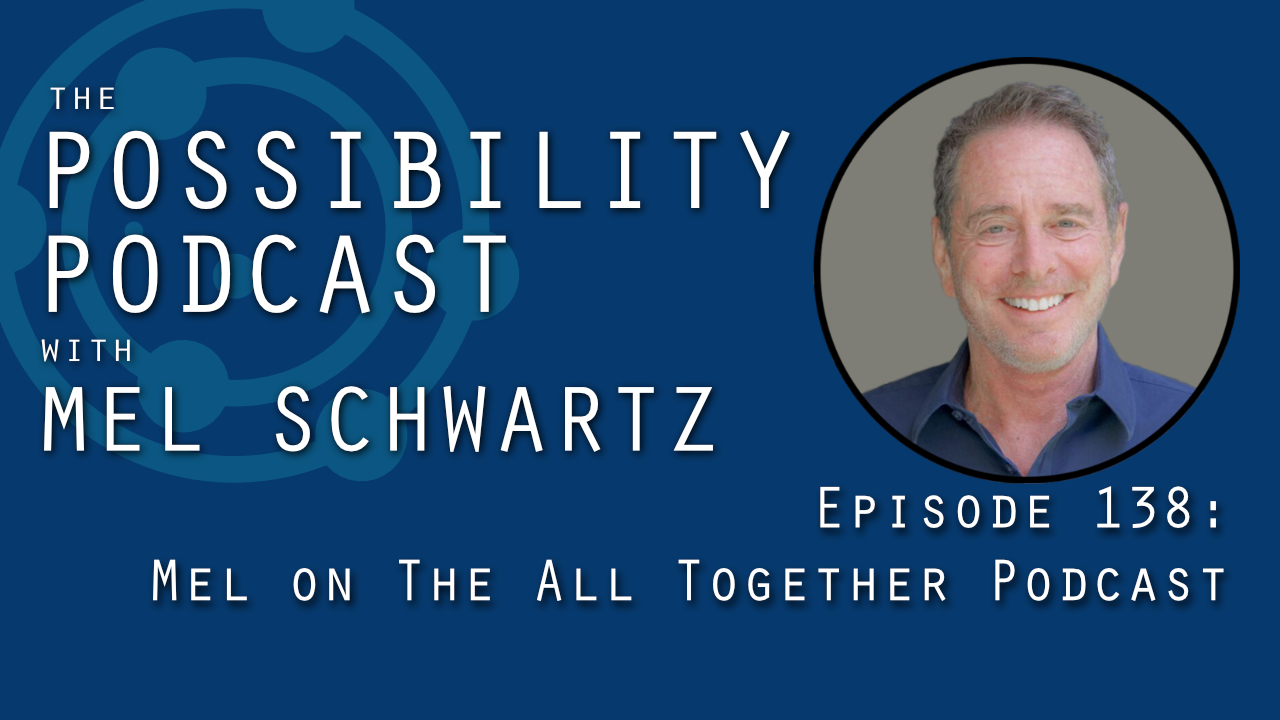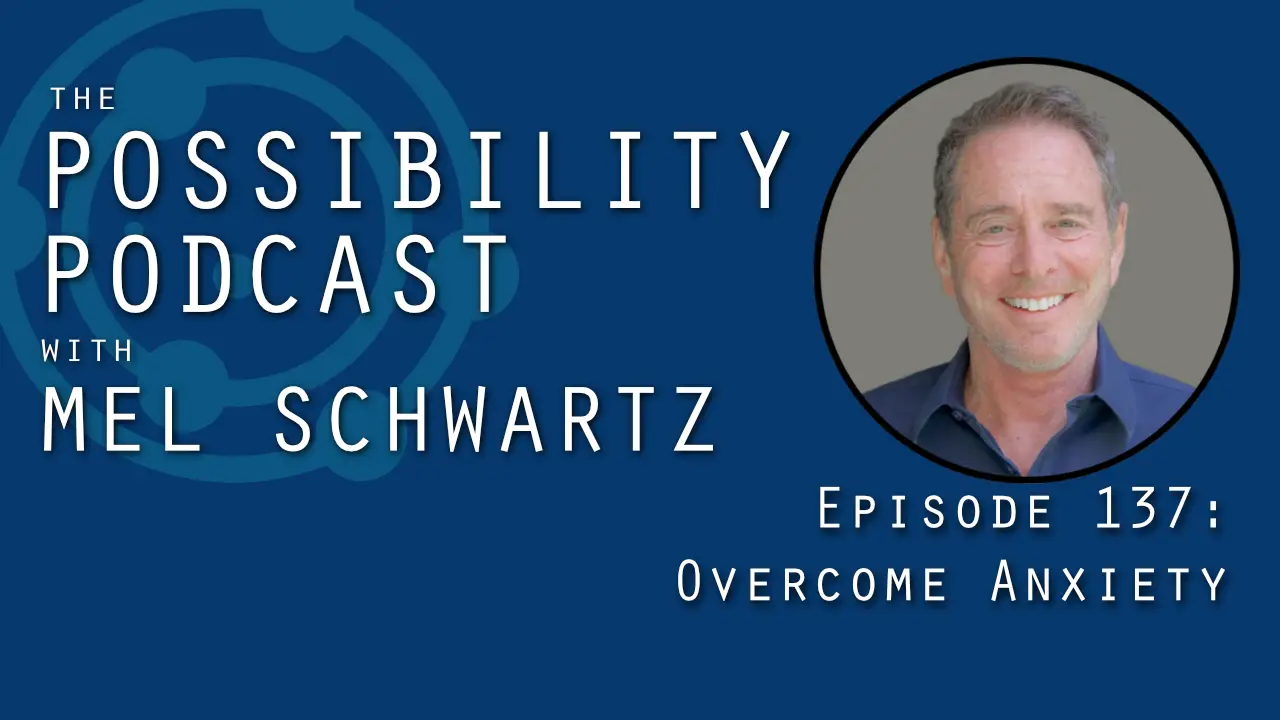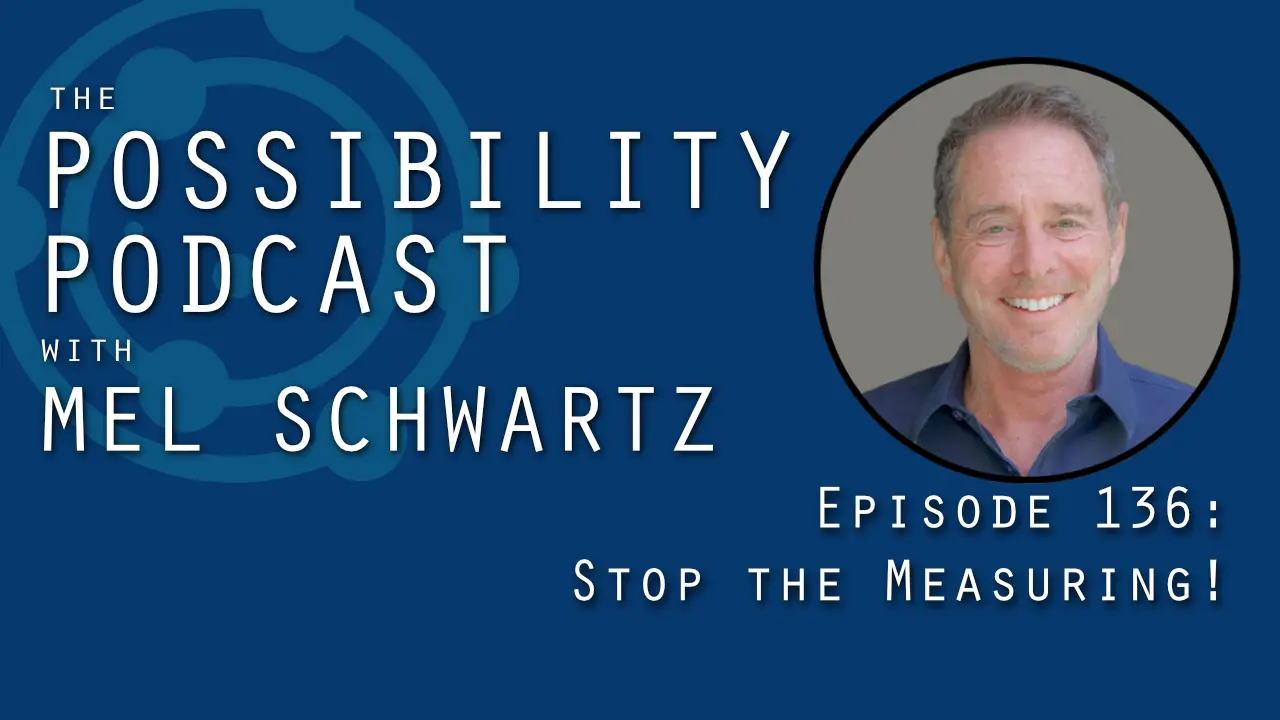Podcast: Play in new window | Download
In this episode 76 of The Possibility Podcast with Mel Schwartz, I share what I think of as the Tao of Communication. Like a martial artist leaning into a conflict in order to redirect the energy of the engagement, you can adopt a sense of flow to defuse arguments and arrive at a win-win conclusion.
Listen to discover…
Interested in bespoke marriage and relationship counseling from Mel Schwartz? Reach out!
- why it’s all right to put aside your argument for a moment
- how questions validate
- the 5% Rule of communication
- how to develop an exchange of empathy in any conversation
Put the Tao of Communication into practice and let me know how it goes for you! Share your thoughts and experiences in the comments!
Subscribe to The Possibility Podcast with Mel Schwartz
Don’t miss a single Possibility Podcast with Mel Schwartz! Subscribe for free in iTunes / Apple Podcasts, YouTube, Spotify, RadioPublic, Spreaker, or wherever you listen to podcasts. Or, simply copy / paste the RSS link directly into the podcast app of your choice!
Please Rate and Review
If you enjoy The Possibility Podcast with Mel Schwartz, please take a moment to rate and review the show in iTunes / Apple Podcasts or Podchaser. It only takes a few minutes, and adding your review is as easy as clicking this link.
Your rating and review helps raise the visibility of The Possibility Podcast with Mel Schwartz, especially on iTunes / Apple Podcasts, which is one of the biggest podcasting platforms today. More visibility for the show means more listeners… and that growth means the show reaches — and helps — more people like you.
Thank you!
Talk With Mel!
Help others when Mel helps you: Contact Mel and find out how you can be a caller on the show and ask Mel a question. He’ll put the Possibility Principle to work for you, and your conversation will be recorded for use in a future episode of the podcast so other listeners can benefit.
Transcript of The Possibility Podcast with Mel Schwartz #076
Hello everybody, and welcome to the Possibility Podcast. I’m your host, Mel Schwartz. I practice psychotherapy and marriage councelling, and I am the author of The Possibility Principle, the inspiration and the companion to this podcast.
I’ll be introducing you to new ways of thinking, a new philosophy and a new game plan for life, and all of the infinite possibilities that await you.
Welcome to today’s episode: Leaning In: the Tao of Communicating.” Let me begin first with the word Tao. It’s spelled t a o, as many of you may already know, and simply put Tao refers to flow. You know, we have an expression that’s common nowadays, “get in the flow.” Easier said than done, but flow, Tao, requires learning to get out of my own way so I can be my own best ally. Essentially, this requires not reacting, not defending, but leaning in.
Now, leaning in is counterintuitive if we are in a conflicted or argumentative conversation.
How do we communicate? Let’s take step back and consider the different ways of communicating. There’s body language. There’s facial expression, and the primary way of communicating is of course verbal, which is what we’re focused on in today’s episode.
So in a conflicted or disharmonious communication, when we’re not in harmony, we’re in conflict, somewhere in between, on the edge of conflict, when we are in that circumstance, we’re back on our heels, maybe being defensive, perhaps being aggressive, not truly listening, but maybe preparing our rebuttal; defending ourselves.
Well, from your life experience, how does that work out? How rare is it that actually you reach some kind of detante and mutual understanding, that you come out of that conflicted relationship in a better place than you started. It doesn’t work that way. A win-lose is a lose-lose. We both lose. So the Tao of communicator requires a different energy, a different field of focus: in the flow; leaning in.
So don’t defend, diffuse. Find something to validate. You heard me share a number of anecdotes in previous episodes about how I handle being called an idealist. I leaned in and they said, “Well, thank you. We sure could use more ideals, couldn’t we?” Or when I’m advocating for social causes somebody might say, “You sound like a socialist.” I lean in. I say, “Well, I did use public roads to get here and I do use the mail and I sent my children to public schools. Those are all part of a socialist infrastructure. But are you confusing socialism with Communism?”
You see when you lean in to an accusation it’s like a martial artist. When somebody comes at you with a negative force, you step to the side by leaning in and finding something to affirm. Finding something to validate. When you do that, you shift the energy field entirely.
Now what happens if you can find something to validate? That may be. Well then you still lean in, by asking, “How did you come to see me in that way?” Suppose somebody says, “You seem like a narcissist.” I might lean in and ask them, “How did you come to see me that way? How did you develop that perception of me? How do you see me in a way that I don’t see myself,” but not argumentatively. With curiosity.
Don’t argue the truth. I want to understand your beliefs your perceptions and your experiences. When we move into that Tao of communicating, we start to transcend opposition. We transcend dualistic thinking either or thinking of win and lose. We shift into a win-win.
I’d love to show you my appreciation for your subscribing to and rating this podcast by offering you, a gift to one of the following:
The Power of Mind, a live talk that I gave. Or one of my digital ebooks: Creating Authentic Self Esteem, Overcoming Anxiety, or Raising Resilient Children, and lastly, Cultivating Resilient Relationships. Once you have subscribed, please send an email to mel at mel schwartz dot com and just let me know which gift you prefer. Thanks.
In the middle of a session recently, I found myself saying to a client with whom I was working on developing empathy, I said, “You know to have someone else get into your shoes, first you have to get into their shoes.” That’s what cultivating empathy is. I have to go first if I want an empathic exchange. I need to understand what it’s like to be the other person. So, to do that, you ask them how they came to feel offended or had an issue or problem with some aspect of you. You have to take the lead.
This starts to shift us into a coherent communicating. First you validate, then you pivot and re-educate if you choose to.
So, what do I mean by first validate? Finding common ground. Set aside focusing on the differences so we can collaborate. If planet Earth was attacked by extraterrestrials, we’d find common ground. Republicans and Democrats would be allies. China and the United States would be allied. The common ground would be our planet is under attack. We set aside the differences that fragment us and set us up in opposition.
We can do the same in a one-on-one conversation.
I developed a strategy many years ago which I have done a podcast on called the 5% rule. It’s kind of paradoxical, perhaps counterintuitive.
When you’re in a disagreement, set aside your beliefs and your argument; just put them up on the shelf for the time being. Quiet yourself down and find some small percentage of what you’re hearing that you might agree with. Arbitrarily, I call it 5%. Validate that 5%. “I can understand how you see that about me. Yes, I do have that tendency from time to time. I can appreciate it might put you off.”
When you have validated that small percentage then what has happened, is the other person, to their surprise, is feeling validated and affirmed and guess what? They may now be in the position to take in what you have to say, but timing is key here. You can’t say “Yes, but.” You have to actually legitimately affirm what you’ve heard.
That 5% rule turns conflict toward the path of dialog. So you have to suspend your beliefs and the point you’re trying to make. You can return to it. You’re not pleading guilty as charged. But first you have to validate something. Communication must flow to have shared meaning. I must open to what you want me to say if I expect you to open what I wish for you to see.
I’m going to repeat that because this might be what we call the Tao of communicating. I must first open to what it is you want me to see if I wish you to open to what it is I want you to see. I have to have empathy first. That’s the second rule of the Tao of communicating.
Remember the first is leaning in. When the charge is made against you, try the validate some aspect of that charge. It may actually be so adroit that the argument falls apart because we have new shared meeting about these words: “idealist,” “socialist,” “narcissist.” Ask what do you mean by narcissist? It’s just a word. When we moving to share the meaning, not an argumentative way, this is peaceful. It’s coherent. It’s in the flow. Lean in, and move into the Tao of communicating.
Well thank you and I hope you enjoy this episode. Look forward to sharing more on this topic with you coming soon. Stay well, stay healthy and be in the flow.
I hope you enjoyed this episode of The Possibility Podcast, and I welcome your feedback on this or any episode. Please send me an email at mel at mel schwartz dot com, or leave a comment in the show notes for this episode at melschwartz.com.
If you like what you’re hearing, please take a moment to rate and review the show at Apple Podcasts, Spotify, or wherever you get your podcasts. Your reviews really help boost the visibility for the show, and it’s a great way for you to show your support.
Finally, please make sure to subscribe to the Possibility Podcast wherever you get your podcasts, and that way you’ll never miss an episode.
And thanks again, and please remember to always welcome uncertainty into your life as you embrace new possibilities.




